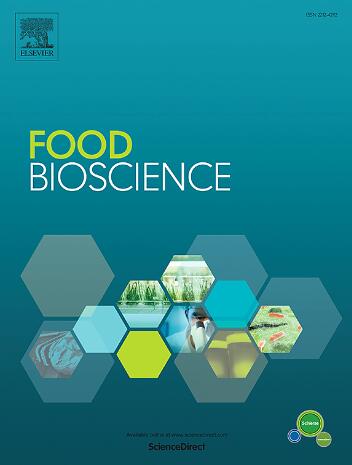抗骨质疏松症牛奶肽的制备、鉴定和筛选:对骨质疏松症大鼠的干预效果
IF 4.8
1区 农林科学
Q1 FOOD SCIENCE & TECHNOLOGY
引用次数: 0
摘要
为了发现牛奶中同时具有抗氧化和钙吸收活性的多肽,以防治骨质疏松症,我们采用了一种全面的筛选方法,包括虚拟酶水解、分子对接和使用成骨细胞进行细胞实验。在双酶水解的最佳条件下,牛奶衍生肽的1,1-二苯基-2-三硝基苯肼(DPPH)自由基清除率和可溶性钙结合能力分别为19.69%和0.6965 μg/mL。通过UPLC-Q-Exactive Orbitrap MS和分子对接,鉴定出了6个肽段,即KEDVPSER、HKEMPFPK、YPSYG、EDVPSE、VPQLE和IPAVF,并进一步进行了验证。在这些多肽中,YPSYG能显著促进MC3T3-E1细胞的增殖(P <0.05),与对照组相比,YPSYG能使细胞增殖率分别提高38.27%和20.67%。此外,YPSYG 还能明显改善 H2O2 诱导的氧化损伤后的增殖(P < 0.05),与模型组相比,增殖率提高了 38.23%。与骨质疏松症模型组大鼠相比,YPSYG 能明显提高大鼠血清碱性磷酸酶(ALP)和 I 型胶原蛋白 N 端前肽(s-PINP)水平,降低耐酒石酸磷酸酶(TRAP)水平(P < 0.05)。此外,牛奶萃取肽和 YPSYG 还能显著提高骨质疏松大鼠股骨和胫骨的骨重指数、最大负荷和弯曲能量(P < 0.05)。此外,这些肽还能明显减少骨质疏松大鼠股骨和胫骨干骺端的破骨细胞数量,减轻微结构损伤。这项研究证实,包括 YPSYG 在内的牛奶萃取肽能有效促进骨质疏松大鼠的骨形成并改善骨的微观结构。这些发现为开发老年骨骼健康功能食品奠定了基础。本文章由计算机程序翻译,如有差异,请以英文原文为准。
Preparation, identification and screening of anti-osteoporosis milk-derived peptides: Intervention effects in osteoporosis rats
To identify milk-derived peptides with both antioxidant and calcium absorption activities in combating osteoporosis, we employed a comprehensive screening approach that included virtual enzymatic hydrolysis, molecular docking, and cellular experiments using osteoblasts. Under the optimal conditions for dual-enzyme hydrolysis, the 1,1-diphenyl-2-trinitrophenylhydrazine (DPPH) radical scavenging rate and soluble calcium binding capacity of the milk-derived peptides were 19.69% and 0.6965 μg/mL, respectively. Six peptide segments, namely KEDVPSER, HKEMPFPK, YPSYG, EDVPSE, VPQLE, and IPAVF, were identified through UPLC-Q-Exactive Orbitrap MS and molecular docking for further validation. Among the peptides, YPSYG significantly promoted the proliferation of MC3T3-E1 cells both with and without CaCl2 (P < 0.05), increasing proliferation by 38.27% and 20.67%, respectively, compared to the control group. Additionally, YPSYG significantly improved proliferation after H2O2-induced oxidative damage (P < 0.05), with a 38.23% higher rate than the model group. Compared with rats in the osteoporosis model group, YPSYG significantly enhanced serum alkaline phosphatase (ALP) and N-terminal propeptide of type I procollagen in rats (s-PINP) levels and decreased tartrate-resistant acid phosphatase (TRAP) levels (P < 0.05). Furthermore, milk-derived peptides and YPSYG significantly increased the bone weight index, maximum load, and bending energy of the femur and tibia in osteoporotic rats (P < 0.05). Additionally, these peptides significantly reduced the number of osteoclasts in the metaphysis of the femur and tibia in osteoporotic rats and alleviated microstructural damage. This study confirmed that milk-derived peptides, including YPSYG, effectively promoted bone formation and improved bone microstructure in osteoporotic rats. These findings provided a foundation for developing functional foods for elderly bone health.
求助全文
通过发布文献求助,成功后即可免费获取论文全文。
去求助
来源期刊

Food Bioscience
Biochemistry, Genetics and Molecular Biology-Biochemistry
CiteScore
6.40
自引率
5.80%
发文量
671
审稿时长
27 days
期刊介绍:
Food Bioscience is a peer-reviewed journal that aims to provide a forum for recent developments in the field of bio-related food research. The journal focuses on both fundamental and applied research worldwide, with special attention to ethnic and cultural aspects of food bioresearch.
 求助内容:
求助内容: 应助结果提醒方式:
应助结果提醒方式:


